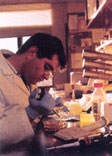  Wrench
in the machinery Wrench
in the machinery
(continued)
Like
healthy cells, cancer cells, too, have the capacity to repair themselves.
The most malignant heal themselves even after assaults from the
most potent weapons medicine can deploy. If Heyer can find a way
to disable the DNA repair machinery in cancer cells, he will render
malignant cells more vulnerable to medical treatment. “Radiation
and chemotherapy kill cancer cells,” the molecular biologist
says. “If we can stop repair, we can kill them quicker.”
Heyer’s large laboratory in the Life Sciences Addition on
the Davis campus is a quiet, modern space. New-age piano music emanates
from a portable stereo. An inflatable plastic tyrannosaurus, a shark
and a cheetah, reminders of evolution and biodiversity, hang from
the ceiling.
The laboratory, which employs 10 research scientists and three undergraduate
students, is a hub of DNA repair research at a university known
for its work in the field. When UC Davis Cancer Center and Lawrence
Livermore National Laboratory three years ago formed a cancer research
partnership — the first such partnership in the nation —
DNA repair groups at the two institutions joined forces, becoming
one of the strongest such groups in the country.
Almost from the initial discovery of the double helix structure
of DNA by Watson and Crick in the 1950s, it was apparent that damage
in one strand of the double helix could easily be repaired, with
the other strand serving as a template. But the field of DNA repair
didn’t take off until the late 1980s and early 1990s. “In
the last 10 years we have seen a phenomenal increase in understanding
of the molecular detail of the repair process,” Heyer says.
“We now know probably most of the key players, what most of
them do and how they interact. We know they all cooperate, they
all work in concert, they all talk to each other.”
  

Home |
Table of Contents |
To our Readers |
Building on Basics
Focusing on Patients |
In Translation |
First Steps
Campus Connection |
Benefactors |
News in Brief
UC Davis Health System |
© 2000, 2001, 2002 UC Regents. All rights reserved. |
 |



 

Edwin
Hjaghnazari, a researcher in Heyer’s lab, uses a plasmid gap
repair assay to investigate DNA repair. |


